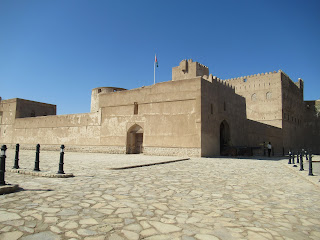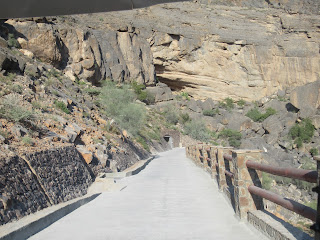Nizwa, Oman
We were camping on the shoulder of Oman's tallest mountain, Jebel Shams, 3009 metres high although we were ony 1,956 metres elevation but it was a cold night. It wasn't helped by some noisy party goers who started their music at 3am plus a lot of shouting. It didn't last long as if someone went over to tell them to be quiet. We were uo before dawn for a walk along a gorge before it got too hot.
A view of the sun striking some distant mountins. This is the place in Oman that sees the first rays of the sun, not because it is a long way east, in fact it is set back from the coast, but it is the highest and hence sees over the horizon furtherest east.
A view along the sheer sides of the gorge, and roughly level with the rest of the path along the cliff face with sheer drops off to the right of the path.
At the end of the path is a huddle of old cliff dwellings.
Looking back along the cliff face.
It was a steep descent after the morning walk to get back to civilisation and a main road to Nizwa, the forer capital of Oman.
Mizwa has a large fort, claimed to be the most visited in Oman with a tower 34 metres high and 40 metres across. The outer entrance to the fort. It was built during the reign of Imam Sultan bin Saif bin Malik Al-Yarubi 1649 - 1679 on a formr defensive site. It is the largest circular tower in the Arabian peninsula.
When you have ignored a no entry sign and ducked under some red and white tape, this is not want you want to see coming towards you.
The inner entrance to the fort...
...the steps up to the main tower...
...inside the main tower...
...looking back towards the river, but at this time of year, just a wadi with a few puddles in the bottom.
Some of the rooms in the castle, furnished as they may have been centuries before...
...another room...
...looking out across the walls, in the middle distance is the roof top cafe of the museum...but it seems that every hotel and restaurant has a roof top area to enjoy the views.
After visiting the museum, I walked along a section of the old wall around the city. Some of it is walkable but som sections are not accessible, sometimes as holes have been knocked in the walls to allow trffic access to the inner city.
Looking down at part of our hotel, located in some former royal palace buildings and royal gardens.
One of the renovated towers along the city walls...
...and a tower undergoing refurbishment...
...and one ofthe city gates from the outside after refurbishment.





























































